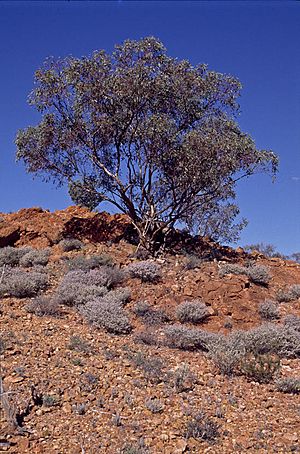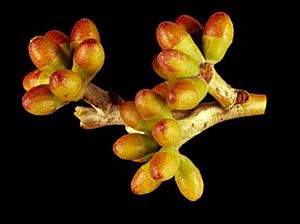Carne's blackbutt facts for kids
Quick facts for kids Carne's blackbutt |
|
|---|---|
 |
|
| Eucalyptus carnei near Leonora | |
| Scientific classification | |
| Genus: |
Eucalyptus
|
| Species: |
carnei
|
| Synonyms | |
|
Eucalyptus carnea C.A.Gardner orth. var. |
|
The Carne's blackbutt, also known as Eucalyptus carnei, is a special type of tree or mallee. It grows only in a certain part of central Western Australia. This plant has smooth grey bark and long, thin adult leaves. Its flower buds grow in groups of seven. When they bloom, the flowers are a creamy white color. After flowering, it produces fruit that looks like a cup or cone.
What it Looks Like
Eucalyptus carnei is a tree or mallee that usually grows from 2.5 to 10 metres (8 to 33 ft) tall. It has a special woody swelling at its base called a lignotuber. This helps the plant regrow after a fire. Its bark is mostly smooth and grey. Sometimes, the bottom 0.5 m (1 ft 8 in) of the trunk has crumbly or flaky bark.
Young plants and new shoots have dull greyish leaves. These leaves are shaped like a spear, about 80–110 mm (3.1–4.3 in) long and 17–30 mm (0.67–1.18 in) wide. The adult leaves are also spear-shaped and dull grey-green on both sides. They are 83–145 mm (3.3–5.7 in) long and 15–30 mm (0.59–1.18 in) wide. Each leaf has a stem called a petiole, which is 13–23 mm (0.51–0.91 in) long.
The flower buds grow in groups of seven. They appear where the leaves meet the stem, which is called a leaf axil. These buds are on a waxy, unbranched stalk called a peduncle, about 7–20 mm (0.28–0.79 in) long. The individual buds sit directly on the stalk or have a very short stem called a pedicel.
Mature buds are not waxy. They are oval to spindle-shaped, about 9–13 mm (0.35–0.51 in) long and 5–6 mm (0.20–0.24 in) wide. They have a cone-shaped cap called an operculum. The flowers are creamy white. They usually appear between February and May. The fruit is a woody, cup-shaped or cone-shaped seed pod. It is 5–10 mm (0.20–0.39 in) long and 6–9 mm (0.24–0.35 in) wide. The parts that open to release seeds are either even with the rim or stick out past it.
How it Got its Name
The plant Eucalyptus carnei was first officially described in 1929. This was done by a botanist named Charles Austin Gardner. His description was published in the Journal of the Royal Society of Western Australia. Gardner found the first example of this plant, called the type specimen, near Sandstone in 1927.
The plant's specific name, carnei, honors Walter Mervyn Carne. He was a plant expert who studied plant diseases. He also supervised fruit and vegetable exports for a government department. He was the first botanist to become president of the Royal Society of Western Australia.
This species belongs to a larger group of Eucalyptus plants. Scientists group them based on their features. For example, its first leaves (called cotyledons) are split in two. Its buds have a scar on their cap, and its small branches have oil glands inside their soft center (called the pith). Eucalyptus carnei is very similar to only one other species, called E. stricklandii. These two plants together form a small group called Stricklandianae.
Where it Grows
Carne's blackbutt is found in certain areas of Western Australia. It grows in rocky, shallow soils, red sand, and on rocky areas with a type of soil called laterite. You can find it in the Goldfields and Mid West regions. Its range stretches from east of Meekatharra and Sandstone all the way into the Great Victoria Desert.



